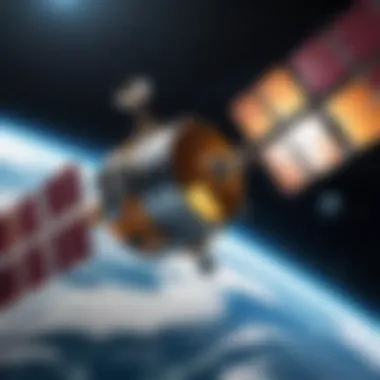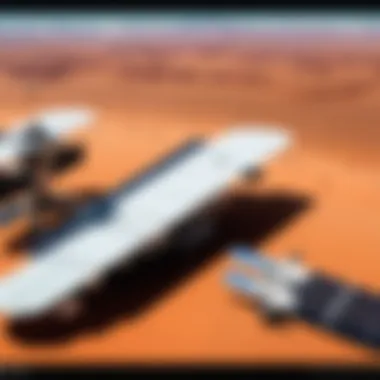Understanding Live Video Satellite Technology


Intro
In today's fast-paced world, where information travels at the speed of light, live video satellite technology plays a crucial role in connecting people and places. This remarkable innovation enables real-time broadcasting across the globe. From intricate scientific missions to daily news coverage, the implications of satellite-based video feeds are far-reaching.
Satellite technology allows signals to reach remote corners of the earth, transcending geographical barriers. It has evolved significantly over the years, adapting to advancements in technology and changing consumer needs. In this comprehensive analysis, we'll dissect the various facets of live video satellite technology, shedding light on its functions, ethical considerations, and its impact on our daily lives.
We will start by taking a closer look at the functioning of satellite systems in the realm of live video feeds. The discussion will further unfold to include use cases that highlight the technology's versatility, along with challenges and advancements that bring this cutting-edge tool closer to everyday users. In a world that's becoming more reliant on instant communication, understanding these elements is key for tech-savvy individuals and gadget enthusiasts alike.
Prelims to Live Video Satellite Technology
In a world that increasingly relies on instantaneous communication, live video satellite technology stands as a testament to innovation. This area of technology is not just a fancy gadget; it plays a pivotal role in countless sectors, from media to emergency management. The growing importance of immediate access to live feeds cannot be overstated. As audiences thirst for real-time updates, this technology becomes increasingly relevant.
Definition and Overview
At its core, live video satellite technology enables the transmission of moving images and sound via satellites orbiting the Earth. Think of it as a medium that connects people regardless of geographical barriers. A simple definition would be that it encompasses the use of satellite systems to deliver video content as it happens, in places where traditional cable or terrestrial signals cannot reach.
The essence of this technology hinges on two primary components: the satellite itself and the ground-based systems that support it. These satellites capture video from specific locations, relay the signal back to ground stations, and distribute it to viewers. This process happens almost instantaneously, allowing for live broadcasts of everything from breaking news to major sporting events.
Historical Context
Understanding the evolution of live video satellite technology begs a brief look back at its origins. The seeds of this technology were sown in the mid-20th century. It was the launch of Sputnik by the Soviet Union in 1957 that sparked a space race, ultimately leading to advancements in satellite communications. By 1967, the first live satellite television broadcast occurred, linking continents through the signal sent from the Intelsat I satellite.
As decades rolled on, the tech flourished. The development of the Geostationary Orbit was crucial, as it allowed satellites to maintain a constant position relative to the Earth. This breakthrough meant that satellite systems began to provide more stable and reliable transmissions. The evolution didn’t stop there; with the rise of digital technology in the 1990s, the quality of broadcasts improved significantly, making live video communication clearer and more accessible to the public.
In summary, live video satellite technology has a rich history that’s intertwined with global events and the ever-evolving realm of communication. It not only reshaped media but also catapulted capabilities in various sectors, laying the groundwork for current and future innovations. Understanding these facets provides a solid foundation for appreciating the broader applications and implications of this technology in today’s world.
The Mechanics of Satellite Communication
The mechanics of satellite communication are the backbone of how live video satellite technology functions, influencing everything from live broadcasts to crucial emergency services. Understanding how this technology works provides valuable insight into its efficacy, reliability, and potential challenges. Satellite communications utilize a variety of technical processes to relay information across vast distances, affecting real-time data transmission significantly.
How Satellites Work
At their core, satellites operate as sophisticated relay stations. They orbit the Earth at specific altitudes, typically ranging from 160 kilometers in low Earth orbit to approximately 36,000 kilometers in geostationary orbit. When a transmission is initiated from the ground, it is sent to the satellite which then retransmits the signal back to another ground station or devices. This relay is crucial for covering large geographical areas and enables communication that would be impossible with traditional wired connections.
These satellites are equipped with transponders that can receive, amplify, and transmit signals. Imagine a vast game of telephone—data is captured in one location, sent up to the satellite, and then beamed back to a distant point on Earth. This system not only supports various forms of communication including voice and data but is essential for delivering live video feeds as well.
Types of Satellites and Their Uses
Various types of satellites serve different purposes in the realm of communication:
- Geostationary Satellites: Sitting high above the Earth's equator, these satellites move in sync with Earth’s rotation. This stability makes them ideal for television broadcasting and weather monitoring.
- Low Earth Orbit Satellites: These satellites fly closer to the earth, significantly reducing signal latency. They are excellent for real-time applications, such as live-streaming video.
- Medium Earth Orbit Satellites: Positioned between the other two types, these satellites balance latency and coverage, often used in global positioning systems.
Each type plays a role in determining the quality and reliability of live video feeds, influencing everything from image resolution to delay in transmission.
Signal Transmission and Reception
Signal transmission and reception in satellite communication involve several technical aspects:
- Frequency bands: Satellites often operate within specific frequency bands, such as Ka band, Ku band, and C band. Each band has its own characteristics, notably regarding bandwidth availability and susceptibility to weather interference.
- Antennas: Ground stations require specialized antennas to communicate with satellites. These can be fixed or mobile, designed to send and receive signals as the satellite moves across the sky.
- Modulation and Demodulation: The process of modulating a signal enables integration into a frequency suitable for satellite transmission. On reception, demodulation converts it back to a usable form.


Understanding these components is essential, as they directly impact the performance of live video satellite technology.
"The efficiency of satellite communication remains critically tied to the understanding of its mechanics, which not only drive current applications but also shape future advancements."
Live Video Feeds: Technical Specifications
The realm of live video satellite technology hinges significantly on its technical specifications. These specifications don't just dictate how well the system performs; they affect every aspect of delivery, quality, and user experience. Understanding them is paramount for ensuring that the technology meets the expectations of its diverse applications, from broadcasting to surveillance.
Resolution and Quality Factors
When discussing live video feeds, resolution is king. The clarity of the image can either engage audiences or leave them frustrated. Higher resolutions like 1080p or even 4K offer crisp images that capture details, enhancing the viewing experience. But here's the kicker: higher resolution generally means larger data files and greater bandwidth usage. For instance, a live feed broadcasted in 4K requires four times the data of a 1080p stream. Finding that sweet spot between quality and data efficiency is crucial for service providers, especially in bandwidth-constrained environments.
"High-quality video resolution transforms how stories are told, making every frame count."
Apart from resolution, other quality factors come into play. Video compression techniques can make a world of difference. Formats like H.265 are becoming the norm for encoding high-quality streams while keeping file sizes manageable. Plus, adaptive bitrate streaming allows the video quality to adjust dynamically based on the viewer's internet speed, ensuring a smoother experience even in suboptimal conditions.
Then, there’s the role of lighting and camera quality. Even a high-resolution feed won’t look good if the lighting isn’t right or if the camera is of poor quality. Let’s not forget, the viewer’s device also impacts the end quality. Screens vary in capability, and a high-res video on a low-quality monitor will fail to leave the desired impact.
Latency Considerations
Another critical aspect of live video feeds is latency, which refers to the time it takes for a signal to travel from the source to the viewer. In a perfect world, latency would be negligible, providing real-time interaction that feels instantaneous. However, in reality, latency can range from a few milliseconds to several seconds, and every millisecond counts in live scenarios.
Low latency is particularly important in applications like online gaming or live sports coverage, where any delay can lead to confusion or dissatisfaction. Factors contributing to latency include the distance the signal has to travel, the compression methods used, and the current network conditions.
Key Latency Factors
- Transmission Methods: Satellite feeds incur higher latency compared to fiber or coaxial cables, largely due to distance.
- Processing Time: Each compression and decompression cycle adds time.
- Network Congestion: Peak usage times can exacerbate delays significantly.
Addressing latency is multi-faceted. Service providers implement various technologies and protocols to minimize delay. Techniques like edge computing, where processing happens nearer to the content delivery point rather than at a central server, are gaining traction.
In summary, keeping an eye on both resolution and latency helps harness the full potential of live video satellite technology. The interplay of these technical specifications directly shapes the quality of experience for users, making it an essential consideration for anyone involved in the field.
Common Applications of Live Video Satellite Technology
In today's fast-moving world, live video satellite technology proves essential across various industries. This capability not only broadens the horizons of communication but also which saves time and resources. Below, we explore some major applications of this technology and consider their impact, necessity, and potential challenges.
Broadcasting and Media
The broadcasting sector represents one of the prime beneficiaries of live video satellite technology. Traditional methods of video distribution have become progressively archaic, unable to meet the demands of immediacy that audiences expect today. Whether it’s a breaking news story or a live football match, satellite technology enables the rapid dissemination of high-quality video feeds.
In broadcasting, several critical factors come into play. To illustrate:
- Real-time Coverage: News networks can set up coverage in remote areas without the need for a complex network of cables or additional infrastructure.
- Global Reach: With a satellite in orbit, broadcasts can reach viewers across the globe, influencing how events are reported and perceived.
- Enhanced Quality: Technologies like 4K and HDR provide a richer viewing experience, especially important for sports and high-stakes events.
However, this rapid dissemination comes with its share of drawbacks. Issues such as signal interference during adverse weather conditions can lead to disruptions in programming, thereby impacting viewer experiences.
Emergency Services and Disaster Response
Live video satellite technology plays a crucial role in emergency services and disaster response scenarios. When natural disasters strike, traditional communication infrastructure often fails, leaving communities isolated. Satellite technology steps in here, providing a reliable means of communication.


Important aspects include:
- Rapid Deployment: Teams can quickly establish communication links in affected areas, delivering real-time assessments that inform relief efforts.
- Surveillance Capabilities: Satellites can provide critical imagery that helps agencies track movement and evaluate damage from a bird’s-eye view.
- Coordination of Resources: By using live feeds, local response teams can coordinate effectively with national and international support resources.
Despite its advantages, there are still concerns regarding privacy and security in these situations. Sensitive information, if not secured properly, can fall into the wrong hands, which demands ongoing focus on regulatory compliance and ethical considerations.
Remote Monitoring and Surveillance
In a world where security is increasingly paramount, live video satellite technology has become instrumental in remote monitoring and surveillance. Whether it concerns military applications or civilian security, the ability to monitor areas from a considerable distance enhances situational awareness.
Key features of this application are:
- Continuous Monitoring: Areas that are hard to access can be observed continuously, allowing for prompt responses to potential threats or anomalies.
- Data-Collection: Live feeds can facilitate data-collection processes important for environments ranging from wildlife conservation to urban planning.
- Accessibility: Real-time visuals help decision-makers develop insight into situations that might otherwise require lengthy travel or complex logistical arrangements.
The challenges here often concern the gathering and storage of data, which can be extensive. Balancing the benefits with ethical implications, including the potential for misuse, remains a significant conversation in this field.
Challenges and Limitations
Understanding the challenges and limitations of live video satellite technology is crucial for grasping its full potential and making informed decisions regarding its usage. These two aspects can significantly affect the effectiveness of satellite communication systems, especially in real-time applications. Knowing these hurdles helps users to mitigate risks and enhance the overall experience of live video feeds.
Weather Interference
Weather plays a significant role in satellite communication. One of the primary issues is heavy rain, which can cause what is known as rain fade. This phenomenon occurs when raindrops absorb and scatter signals, leading to a loss in signal strength. Other weather-related factors like snow, fog, and even strong winds can contribute to this interference, hampering the clarity of live video feeds.
In practical terms, if you're trying to broadcast during a storm, you might notice sudden interruptions or pixelation in your feed. The technology, while advanced, isn’t foolproof.
To better understand the impact of weather, consider the following points:
- Signal Strength: Signals can degrade significantly during inclement weather.
- Backup Solutions: Many broadcasters use terrestrial or fiber-optic links as backups during bad weather episodes.
- Operational Adjustments: Satellite operators may have to lower throughput during adverse weather conditions, diminishing the overall efficiency.
It's crucial for service providers to constantly monitor weather conditions and make adjustments in real-time to ensure reliability of their services.
Cost Factors
The cost of implementing and maintaining live video satellite systems can be hefty. First off, acquiring necessary equipment—including satellite dishes, encoders, and the satellite itself—demands a considerable upfront investment. Not to mention the operational costs related to maintenance and potential upgrades.
Additionally, ongoing expenses like leasing satellite bandwidth can often accumulate fast. The price you pay might vary based on the bandwidth you use as well as the service provider’s rates, sometimes leading to unpredictable costs that can burden less prepared organizations.
Key considerations regarding costs include:
- Equipment Costs: High-quality equipment can be expensive, impacting initial investment and ROI.
- Operational Expenses: Monthly or yearly fees for signal transmission can impact overall budget plans.
- Insurance and Risks: Insuring equipment and factoring in potential outages must also be considered for comprehensive fiscal planning.
Investing in live video satellite technology can be a worthwhile venture if done judiciously, weighing both initial and ongoing costs against the potential return on investment.
"Understanding both the challenges and costs involved is just as critical as knowing the technology itself. Ignorance can lead to unexpected financial burdens and operational bottlenecks."
By recognizing these challenges and limitations, stakeholders can take proactive steps to build resilient systems, ensuring a more reliable and effective use of live video satellite technology.
Ethical Considerations in Live Video Streaming


The rise of live video satellite technology brings with it a host of ethical considerations that cannot be ignored. As society becomes more entwined with digital connectivity, questions of morality and responsibility often come to the forefront. This section looks into both privacy issues and regulatory compliance, which are central themes in the conversation surrounding live streaming and satellite technology. By understanding these elements, individuals and organizations can navigate the digital landscape more responsibly.
Privacy Issues
Privacy has become a hot-button topic in today’s digital age, largely due to the increasing capability of live video technology. When people engage in live streaming, especially in public spaces, their actions are sometimes captured and broadcast without their knowledge or consent. A clear example can be drawn from the ramifications of live-streaming events like protests or gatherings where individuals may not wish to be featured. The issue here is multifaceted:
- Informed Consent: Individuals should ideally be aware that they are being filmed. However, not all situations allow for easy disclosure. This sparks a debate over how to ethically balance the right to document events with the rights of individuals in those environments.
- Data Collection: Many platforms automatically collect data related to user engagement. This can include location data, viewing habits, and personal information, which raises questions regarding how this data is utilized and stored.
- Potential for Misuse: With the capability to capture high-quality live video, misuse of footage can occur. For instance, a recorded altercation could be taken out of context and shared widely, potentially harming reputations.
In essence, the challenge lies in developing robust systems that respect privacy while still promoting freedom of expression and accessibility to information. Awareness and educating users about privacy norms plays a vital role in addressing these issues.
Regulatory Compliance
The landscape of regulatory compliance is equally intricate when discussing live video satellite technology. Laws and regulations vary significantly across jurisdictions, making it boggling for content creators and providers alike. Key considerations include:
- Legal Frameworks: Countries have different legal standards regarding surveillance and data protection. What may be permissible in one area might be strictly prohibited elsewhere. Understanding these nuances is crucial for any entity operating across borders.
- Licensing and Permissions: Live video streaming often necessitates special licenses, especially when broadcasting from certain locations or events. Failing to secure these can lead to substantial penalties and legal issues.
- Content Moderation: Platforms must be proactive in moderating content to comply with laws pertaining to hate speech, violence, and other sensitive subjects. Failure to do so can attract significant legal repercussions.
"In the realm of technology, ethical dilemmas are not merely about adhering to law; they also encompass a broader sense of social responsibility."
Future of Live Video Satellite Technology
Live video satellite technology is embarking on a significant transformation, promising to reshape the way we communicate and share information globally. Understanding its future is crucial not only for industry professionals but also for the general public, who are increasingly reliant on real-time communication. As the demand for high-quality, uninterrupted live video feeds grows, various elements of this technology must adapt and evolve.
Technological Innovations on the Horizon
With advancements in satellite technology, we observe a wave of innovations aimed at enhancing live video streaming.
- Higher Resolution Feeds: As UHD and 8K televisions become more prevalent, so does the need for content that meets these standards. Satellite technology is progressively including capabilities to transmit higher resolution feeds. Companies are testing new compression techniques that maintain quality while reducing bandwidth demand.
- Low Earth Orbit (LEO) Satellites: Traditional satellites are often positioned in geostationary orbit, resulting in higher latency. However, innovations such as LEO satellites are being deployed to mitigate this issue by providing lower latency capabilities and increased bandwidth. These satellites orbit closer to Earth, allowing quicker signal transmission.
- Integrated AI Applications: The infusion of artificial intelligence in satellite operations is gaining traction. AI can optimize signal processing, manage bandwidth allocations efficiently, and even aid in content creation by analyzing viewer behavior and preferences.
"The future of satellite technology isn’t just in enhancing transmission capabilities; it’s about understanding user needs and adapting dynamically to them."
Such innovations are not merely technical; they also hold the potential to improve accessibility to satellite-based services.
Potential Growth Areas
As technology progresses, the live video satellite landscape is ripe for exploration in several specific growth areas:
- Telemedicine: The expansion of live video satellite tech can facilitate remote consultations, especially in rural and underserved communities. Health professionals can conduct real-time assessments and deliver timely care effectively, regardless of location.
- Emergency Response: With the unpredictability of natural disasters, the integration of real-time satellite feeds becomes invaluable. First responders can obtain live information during crises, helping coordinate rescue efforts and ensuring maximum efficiency in saving lives.
- Entertainment and Content Creation: With the rise of streaming platforms and social media, satellite technology presents opportunities for creators to broadcast live events from anywhere in the world, engaging a global audience without the expensive infrastructure typically needed for such reach.
- Education and Remote Learning: Providing live classes and events in distant locations through satellite coverage can enhance educational opportunities, breaking geographical boundaries and allowing students access to real-time instruction from experts.
The future of live video satellite technology is undeniably bright, fueled by technological advancements and evolving user demands. Both new industries and existing sectors stand to gain tremendously as these innovations take root, ushering in an era of enhanced connectivity and accessibility.
Culmination
In wrapping up this exploration of live video satellite technology, it becomes clear that this domain is not merely a technical curiosity, but a critical component of modern communication and media landscapes. Understanding how live video satellite systems function and their applications enables individuals, businesses, and institutions to harness this technology effectively in various contexts, from broadcasting to emergency responses.
Recap of Key Points
Live video satellite technology is multifaceted, bringing together several elements that work cohesively. Here’s a quick review of what’s been discussed:
- Definition and Overview: We initiated our discussion by clarifying what live video satellite technology actually involves, establishing a foundational understanding.
- Mechanics of Communication: Explored how satellites transmit and receive signals, shedding light on types and their specific functions.
- Technical Specifications: Discussed video quality and latency factors that can impact the viewing experience, emphasizing their importance for real-time applications.
- Applications: Highlighted various areas where this technology finds relevance, including media, emergency services, and surveillance.
- Challenges: Weather impacts and costs were dissected, identifying potential hurdles for users.
- Ethical Considerations: Examined privacy and regulatory issues, which are increasingly critical in our data-driven world.
- Future Prospects: Looked at innovations on the horizon and potential growth areas, framing the ongoing evolution of this field.
These points not only paint a picture of current technology but also hint at future trends and directions.
Final Thoughts
Summing everything up, the significance of live video satellite technology cannot be overstated. As technology continues to evolve, this form of communication offers invaluable benefits that range from immediacy in news reporting to critical support in emergencies. However, with these benefits come responsibilities, particularly concerning ethical practices.
Despite hurdles like costs and weather disruptions, the ongoing innovations point toward a brighter future. As we delve deeper into this technology, both consumers and professionals alike must consider the broader implications of this connectivity, especially as we navigate an increasingly interconnected world. Ultimately, understanding these dynamics prepares us to effectively adapt to and harness the power of live video satellite technology.





